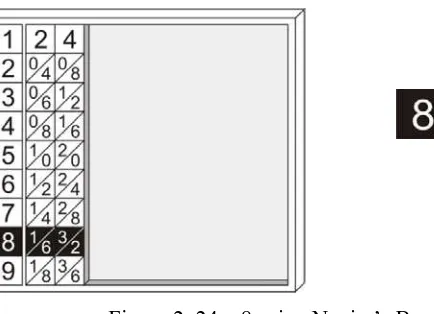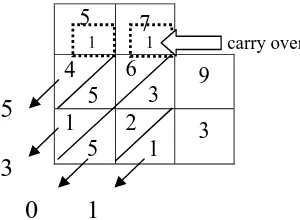International Seminar and the Fourth National Conference on Mathematics Education, Department of Mathematics Education, Yogyakarta State University, 21-23 July 2011
1
Adapting the concept of Napier’s bones to teach multiplication
for elementary students
Muh Wildanul Firdaus Sri Andayani
Mathematics Education Department Yogyakarta State University
Abstract
Napier's bones is a tool created by John Napier for calculating a products and quotients of numbers. The tool was used as a basic of designing the operation concept in creating early computer. The tool can conduct multiplication, division, and compute square root. In this paper we are focused on multiplication.
Based on the concept of Napier’s bones, we can adopt it to teach multiplication for elementary students. The concept is simple and easy to be applied for elementary school students, because there are so many problems in elementary school related to multiplication. It will make the teaching and learning of mathematics to be more interesting.
Keyword: Napier’s bones, teach multiplication, interesting, elementary students.
I. INTRODUCTION
Mathematics is one subject that is quite feared and hated by elementary students. The fear of anything to do with numbers is embedded in not just children but also adults. However, the fault lies not with this subject, but with the teaching methods used to convey it. It can be caused by the way of teachers in introducing mathematics to their students. In teaching learning process, teachers which only teach conventionally will make their students saturated, and instill feeling of dislike of mathematics.
Teaching mathematics to elementary students is critical for establishing a foundation of success in mathematics. There is a need for some basic memorization of facts, because students who do not memorize arithmetic functions struggle in upper grades. Therefore, teaching mathematics must be fun and interesting.
International Seminar and the Fourth National Conference on Mathematics Education, Department of Mathematics Education, Yogyakarta State University, 21-23 July 2011
3
Napier's rods in the rim to conduct multiplication or division. The board's left edge is divided into 9 squares, holding the numbers 1 to 9. The Napier's rods consist of strips of wood, metal or heavy cardboard. Napier's bones is three dimensional, squares in cross section, with four different rods engraved on each one.
From figure 1 is known that each rod consists of 9 squares split by diagonal into upper and lower section. Each squares consists a number as result of multiplication the number of rod with number 1 to 9. The upper section holds the tens of the multiplication, and the lower holds the unit.
B. How to Use the Napier’s Bone
Given the described set of rods, suppose that we wish to calculate the product of 24 and 8. Place inside the board the rods corresponding to 24, as shown in the diagram, and read the result in the horizontal strip in row 8, as marked on the side of the board. To obtain the product, simply note, for each place from right to left, the numbers found by adding the digits within the diagonal sections of the strip (using carry-over where the sum is 10 or greater).
Figure 2. 24 x 8 using Napier’s Bones
From right to left, we obtain the units place (2), the tens (6+3=9), the hundreds (1). We get the result is 192.
Let’s try for other example, e.g. 42 x 358. Now we try using Napier's bones directly. Note that we must put 2 rods, i.e. 4 and 2 on the boards, as shown in the picture below. Then, we do addition to the number that separate by diagonal. So, we get 1 (2+2) (3+1+6) (2+1) 6 =15036.
Figure 3. 42 x 358 using Napier’s Bones
The basic of this concept is by making group among the numbers written in the rod. Look at bottom right corner from the second example, you will find 6 at the bottom right corner. This number shows that it-self is a unit. Then the next, 2 1 0 is a tens, where 3 0 1 6 is a hundreds, that we must do summation on it. Also 2 2 0 and the last is 1 at the top right corner.
C. Adapting the Concept of Napier’s Bones
We do not have to create the tool to teach the multiplication. We just only need to adopt the concept of Napier’s bones. We need to draw a table as the figure – the size of table is depending on the number the digit. Here are the steps to use the concept to teach multiplication.
For example, we will solve 57 x 93 using the concept of Napier’s bones. 1. Draw two columns to put the number 5 and 7 to represent 57
5 7
2. Draw third column to put the number 9 and 3 to represent 93 vertically, as shown below
5 7 9 3
1
5
0
International Seminar and the Fourth National Conference on Mathematics Education, Department of Mathematics Education, Yogyakarta State University, 21-23 July 2011
5
3. Draw a diagonal line across each empty squares
5 7 9 3
4. Multiply 5 by 9, and put the results into the appropriate square, that is below 5 and the left of 9. Put the ten into upper section and the unit into the lower.
5 7 4
5 9 3
5. Repeat step 4, to fill the other square, so we get a table as shown below.
5 7 4
5 6
3 9 1
5 2
1 3
6. Add the numbers in each diagonal from the right to the left. If there is a carrying number, put the carry to the left diagonal
5 7 4
5 6
3 9 1
5 2
1 3
0 1
Figure 4. Applying concept of Napier’s bones to solve 57 x 93
7. So we get the result is 5301. 5 x 9 = 45
1 carry over
5
3
This step also works for larger numbers, for example 3973 x 572. The result of multiplication is 2,272,556 and the table is shown as follows.
3 9 7 3 1
5 4 5
3 5
1
5 5 2
1 6 3
4 9
2
1 7 0
6 1 8
1 4
0
6 2
2 5 5 6
Figure 5. Applying concept of Napier’s bones to solve 3973 x 572
From the two examples above we can conclude that performing multiplication using the steps is more easy than usual. However, there are several requirements that must be mastered for students to complete the multiplication by using the concept. The requirement is that students have mastered the multiplication below 100 and students can add multiple numbers using carry-over where the sum is 10 or greater.
Based on the conditions, the multiplication using the technique of Napier's bone is suitable for students in the fifth and sixth grade.
II. CONCLUSION AND SUGGESTION
Conventional method of teaching is not enough in teaching learning process in mathematics, moreover in elementary school. Mathematics teacher needs a technique to create learn mathematics more interesting, to prevent student bored and having feeling of dislike of mathematics.
Napier’s bones concept can be adopted as a technique to teach multiplication for students in the fifth and sixth grade that makes mathematics become interesting. This concept needs requirement i.e. students have mastered multiplication one through ten and addition which has carry-over. However, the concept is more easy
2
2
International Seminar and the Fourth National Conference on Mathematics Education, Department of Mathematics Education, Yogyakarta State University, 21-23 July 2011
7
and fun for students than the usual technique. Furthermore, this technique can also be used for students at higher levels.
III.BIBLIOGRAPHY
John Keplin. 2002. An Illustrated History of Computers Part 1.
http://www.computersciencelab.com/ComputerHistory/History.htm accessed
on July 8th 2010
John Napier. http://en.wikipedia.org/wiki/John_Napier accessed on July 8th 2010 Napier’s Bone. http://en.wikipedia.org/wiki/Napier's_bones/ accessed on July 8th



